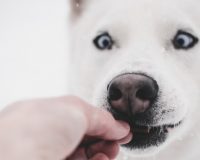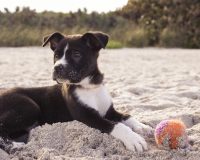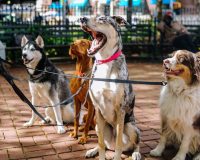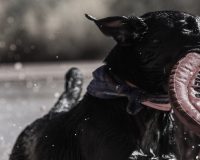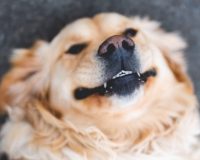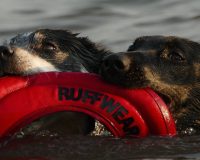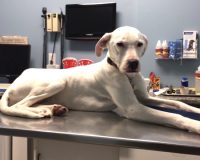
Leash-Free Park Etiquette
By Erin Britton, CPDT-KA, Instructor, When Hounds Fly | Sentience | Dogs 101 | June 23, 2019
Visiting an off-leash park is a great way to exercise and socialize pups. Most dogs need 1-3 hours per day of cardio and the social stimulation that off-leash parks offer. When you visit a dog park, though, you should be aware of a few things. Everybody wants to have a fun, safe time with their pup. But what are everyone’s obligations—Parent and Walker, alike?
The person with the dog is responsible for the dog
Be engaged, vigilant, aware and ready to act. If your dog poops, pick it up (in case of a medical/health issue that prevents pickup, just ask for help). On the other side of that coin, when you enter a dog park, know that there might be a dog or dogs in there that are not perfect. Keep your knees bent and stay on high alert. Getting knocked over by running dogs is just not fun. It happens.
“Dog owners and or commercial dog walkers are legally responsible for their own dog(s) and any injuries or damage caused by their dog(s). Individuals who choose to use off-leash areas do so at their own risk.“ (Source: City of Toronto, 2019)
Safety is Key
While the park is dog paradise, there will always be some hazards around. In order to keep your dog safe, practice watching for these things and proactively dealing with them.
• Changes in dog behaviour
• Newcomers to the park
• Where your dog is, vis à vis gates opening/closing
• Is your dog charging to greet or gate-crowding? If so, call the pup away to allow newcomer entry
• Poop eaters (the dogs not the humans. Hopefully.)
Let’s talk a little more about watching for changes in dog behaviour. You know your dog and what behaviours and movements are normal for them. If you notice your dog giving you the “can we go now?” look, or sending the “back off” look to another dog, the best way to deal with it is to intervene before it escalates. If the pup is uncomfortable, lead him/her away to somewhere they are more comfortable. Be alert and always advocate for your dog.
The harder part of pre-empting dog behaviour is when it’s not your dog giving off signs that they are uncomfortable, it is someone else’s. What do you do in this situation? If you see another dog that is so uncomfortable that it’s becoming dangerous, remove your pup from the situation/area. The number one rule is make sure your dog is safe. Why not just yell at the owner/walker to do something about their crazy dog? Because this doesn’t always work, and certainly will raise the tension overall in the park. The most effective, proactive, direct and reliable option is to keep a close eye on dynamics and manage your dog’s reaction and safety.
Safety Tips for Parks
• Engage with your dog. Play, encourage check ins, and keep the pup happy.
• Monitor your pup and their play. You cannot be proactive if you don’t see something coming.
• Stay close to your dog. It’s much easier for them to hear you and respond to commands when you are close. It’s easier on your vocal chords too.
• Don’t let your dog get aggressive with another dog. Dogs don’t have to like all dogs. Not all humans get along either.
• Phones and conversations prevent engagement with our pups. Take a break from the digital world and be with your pup.
• Bringing young children into a dog park is just not safe. Dogs are not allowed in playgrounds for good reason: the two don’t always get along. A child is more likely to be chased, knocked down (or worse) if they are running, emitting high-pitched sounds and if they have food/toys. For parents who must bring young children into leash-free, minimize the risk by keeping the child quiet, still and close.
Poopy Gifts
Everybody’s favourite topic: poop. It’s a fact of life, and part of the dog park. The best way to keep our parks clean and safe for continued use is to pick up what comes out. It makes it easier if you think of it as treasure.
The reality is dog feces needs to be cleaned up for a variety of health reasons, not only because it stinks. Feces is a paradise for bacteria and parasites. Our poor pups are closer to the ground than we are, with their noses often IN the poop (sometimes eating it). We definitely do not want them contracting a disease—giardia comes to mind. Poop that is left where it landed often ends up on somebody’s shoes, or on other dogs’ paws, and the bacteria and parasites catch a free ride right into your home. Contrary to popular belief, dog feces is not a good fertilizer. In actuality, it usually kills whatever vegetation it is near. We also do not want the dog poop sticking around and contaminating the water in the park either. It’s good practice to stop your pup from drinking from puddles in the park. Believe that all puddles are contaminated.
Toys are not always welcome and some toys kill dogs
“What!?!?” you gasp. Yes! The better the toy, the more competitive the environment becomes. Your dog may be a classic ball chaser, and loves to do nothing but ball. But not every dog has manners when it comes to toys. Now some people might say, “Well they shouldn’t bring that dog in”. Maybe they’re right. But until that ball-obsessed dog isn’t in the park anymore, your dog’s safety is at risk. If you want to minimize the risk, minimize the triggers. Leash-free parks exist so that pups can run, unfettered, and socialize safely. They can still be a fun place without toys.
Toys kill? Yes, every year. Any toy that is small enough to be swallowed kills dogs. That includes tennis-sized balls. If you absolutely must bring toys with you, make sure they are oversized and impossible to swallow by any dog of any size.
Dogs LOVE food
When bringing treats/food into the park, be aware that some dogs may follow you around, begging constantly. Don’t get annoyed at them—you’re the one that brought food into the park and called their noses over.
Put the food away and gently say no, go away, no more, etc., and ignore the dog (do not push them off, hit them, or yell at them). Or opt for the easier option of just not bringing goodies into the park.
Humans in the Dog Park
Dog parks can be stressful for humans too. When it isn’t going as we planned and our dog is getting picked on, or started a fight, or isn’t playing, or is playing too rough, we need to manage ourselves. In fact, to effectively manage our dogs, we have to manage ourselves and our stress levels. Adrenaline is difficult to deal with, but keeping your body language and tone of voice in control will help you navigate your dealings with both dogs and humans. Remember that dog parks are a public space. You’ll see all kinds (dogs and people). Breathe and collect yourself before acting. Have a plan and you’ll find your dog park visits get easier. Keep in mind that you know your dog, but other people don’t. Advocate for your dog while respecting other park users.
Be honest with yourself
Not every dog is a good fit for the dog park. Yours may not be if:
• Your dog is shows signs of fear—tail tucks, paw lifts, shaking—in the dog park and does not leave your side (or the corner, or the gate, or the bench, etc.)
• You have an aggressive dog that picks fights with others, including puppies
• You have a resource-guarding dog (i.e. they guard sticks, holes, toys or the fountain aggressively)
• If your dog is sick or not up to date on vaccinations, they cannot go to the park
• You have an intact (un-neutered) male that triggers other dogs’ bad behaviours
• You have a female who is in heat
• Your dog is too young (under 4 to 5 months and not yet fully vaccinated).
For more information on dog park etiquette, check out this article by the OSPCA: Dog Park Etiquette
Still have questions? Ask the CDWA.


